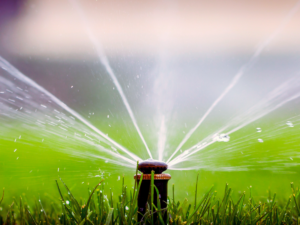
Signs Your Irrigation System Has a Leak
Tips from Lawn Sense – Lawn Sense means no-nonsense.
Let’s face it—no one likes a soggy lawn unless you’re a duck. But your sprinkler system might be the culprit if you’ve noticed your yard looking more like a marsh than a manicured landscape. Sprinkler leak locating isn’t just about saving money; it’s about keeping your landscape healthy and your water bill in check.
We’ve been in this business long enough to know that irrigation leaks rarely announce themselves with fanfare. They sneak up on you—quiet, persistent, and pricey. So, how do you catch them before they drain your wallet and drown your flower beds? That’s precisely what we’re diving into.
1. Spongy or Oversaturated Lawn Patches
Ever walked across your lawn and suddenly felt like you stepped into a wet sponge? That squishy spot could be a leaking sprinkler line. Water from an underground leak has to go somewhere—usually, it finds the path of least resistance to the surface.
If you consistently find overly wet areas, even when the system hasn’t run, it’s time to investigate. We’ve seen spots like these ruin flower beds, weaken tree roots, and even invite pests like mosquitoes.
2. Sky-High Water Bills Without Warning
You’ve been watering on the same schedule, with no changes. But suddenly, your water bill shows up, and it’s more bloated than a beach ball in July.
It’s easy to overlook a leak when everything seems to be working. But if you’re paying more and getting less, there’s a chance water is being wasted underground or through tiny cracks in your sprinkler heads. That’s your system silently bleeding cash.
3. Dying Grass Next to Green Grass
Here’s a head-scratcher: one side of your yard looks like Augusta National, while the other’s hanging on for dear life.
Leaks often mess with water distribution. One area may get too much, while another gets barely a trickle. It’s not your lawn’s fault—it’s just caught in the crossfire. When we check out these situations, we usually find an uneven pressure problem or a damaged sprinkler head sending water in every direction except the right one.
4. Mold or Mildew Near Sprinkler Zones
If you spot mold or mildew near your sprinkler heads or valves, that’s a big waving red flag. A leak doesn’t just waste water—it also creates the perfect playground for mold to thrive.
We’ve had clients tell us, “I thought it was just shady back there!” But then we dug a little, and the leak was found, the mold cleared, and the problem was solved.
5. Water Pressure That’s All Over the Place
Too strong? Too weak? Sprinklers that shoot like fire hoses or barely drool out a trickle? Inconsistent pressure is often a sign that something’s wrong underground.
A break or leak in the main irrigation line can disrupt the flow across the entire system. We’ll check pressure zones, look for broken heads, and run diagnostics until we know what’s going on. Again—Lawn Sense means no-nonsense.
6. Visible Cracks or Spraying from Sprinkler Heads
If your sprinkler heads are misting when they should be streaming, or you see water dribbling down the side of the head instead of spraying outward—something’s broken.
It might seem small, but even a minor crack can waste gallons of water daily. Think about that for a second—your sprinkler could leak more water in a week than your family drinks in a month.
7. Bubbling Water Around Valves or Emitters
Picture this: you’re sipping your coffee, admiring your lawn, and notice a soft gurgling sound or bubbling water around a valve box. That’s not your yard saying hello—it’s a buried leak asking for help.
A broken seal, faulty valve, or hairline pipe crack could let water escape 24/7. These are the kinds of things we see all the time during sprinkler leak locating. You may not see the damage immediately, but your utility bill and dead plants will fill you in soon enough.
8. Odd Noises When the System Runs
Your sprinkler system shouldn’t sound like an old radiator. Whistling, banging, or high-pitched squealing is a sign that it needs attention.
These noises can mean trapped air, pressure irregularities, or—you guessed it—a leak. Give it a listen next time your system runs. Your ears might tell you what your eyes can’t see.
FAQ: Sprinkler Leak Locating
How often should we inspect our irrigation system?
We check for leaks, faulty heads, and pressure problems at least twice a year—once before the season starts and once mid-season.
Is it better to DIY or call in the pros?
You can do a visual check yourself—look for pooling, dying patches, and spraying issues. But for underground leaks or pressure diagnostics, it’s safer and faster to let us handle them.
What happens if I ignore a small sprinkler leak?
That “small” leak can cost you hundreds, damage your lawn, and promote mold. What starts as a drip can turn into a deluge—fast.
How do you locate hidden leaks?
We use a combination of visual inspection, pressure testing, and acoustic equipment or leak detectors to listen for leaks underground. It’s not guesswork—it’s Lawn Sense.
Ready to Stop the Drip?
Sprinkler leak locating isn’t about overthinking—it’s about overwatering in places you didn’t intend. If any warning signs sound familiar, it’s time to take action.
We’ve worked with homeowners who didn’t even realize there was an issue until the damage was done. That’s why we always say—don’t wait for the swampy lawn or sticker shock from your next bill.
Give us a call. We’ll bring the experience, the gear, and the straight talk.
Because at the end of the day, Lawn Sense means no-nonsense—results that make your lawn greener and your life easier.